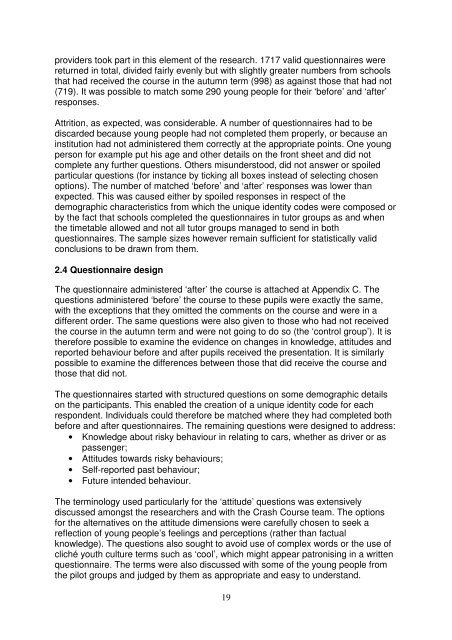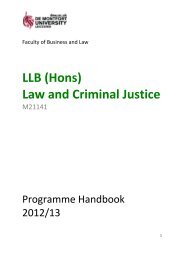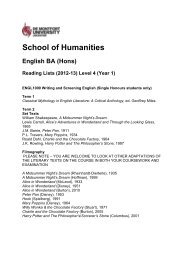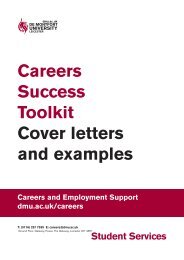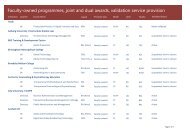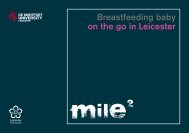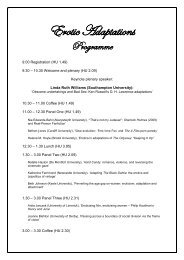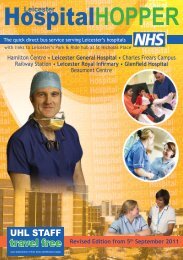Evaluation of the Crash Course March 2009 - De Montfort University
Evaluation of the Crash Course March 2009 - De Montfort University
Evaluation of the Crash Course March 2009 - De Montfort University
Create successful ePaper yourself
Turn your PDF publications into a flip-book with our unique Google optimized e-Paper software.
providers took part in this element <strong>of</strong> <strong>the</strong> research. 1717 valid questionnaires were<br />
returned in total, divided fairly evenly but with slightly greater numbers from schools<br />
that had received <strong>the</strong> course in <strong>the</strong> autumn term (998) as against those that had not<br />
(719). It was possible to match some 290 young people for <strong>the</strong>ir ‘before’ and ‘after’<br />
responses.<br />
Attrition, as expected, was considerable. A number <strong>of</strong> questionnaires had to be<br />
discarded because young people had not completed <strong>the</strong>m properly, or because an<br />
institution had not administered <strong>the</strong>m correctly at <strong>the</strong> appropriate points. One young<br />
person for example put his age and o<strong>the</strong>r details on <strong>the</strong> front sheet and did not<br />
complete any fur<strong>the</strong>r questions. O<strong>the</strong>rs misunderstood, did not answer or spoiled<br />
particular questions (for instance by ticking all boxes instead <strong>of</strong> selecting chosen<br />
options). The number <strong>of</strong> matched ‘before’ and ‘after’ responses was lower than<br />
expected. This was caused ei<strong>the</strong>r by spoiled responses in respect <strong>of</strong> <strong>the</strong><br />
demographic characteristics from which <strong>the</strong> unique identity codes were composed or<br />
by <strong>the</strong> fact that schools completed <strong>the</strong> questionnaires in tutor groups as and when<br />
<strong>the</strong> timetable allowed and not all tutor groups managed to send in both<br />
questionnaires. The sample sizes however remain sufficient for statistically valid<br />
conclusions to be drawn from <strong>the</strong>m.<br />
2.4 Questionnaire design<br />
The questionnaire administered ‘after’ <strong>the</strong> course is attached at Appendix C. The<br />
questions administered ‘before’ <strong>the</strong> course to <strong>the</strong>se pupils were exactly <strong>the</strong> same,<br />
with <strong>the</strong> exceptions that <strong>the</strong>y omitted <strong>the</strong> comments on <strong>the</strong> course and were in a<br />
different order. The same questions were also given to those who had not received<br />
<strong>the</strong> course in <strong>the</strong> autumn term and were not going to do so (<strong>the</strong> ‘control group’). It is<br />
<strong>the</strong>refore possible to examine <strong>the</strong> evidence on changes in knowledge, attitudes and<br />
reported behaviour before and after pupils received <strong>the</strong> presentation. It is similarly<br />
possible to examine <strong>the</strong> differences between those that did receive <strong>the</strong> course and<br />
those that did not.<br />
The questionnaires started with structured questions on some demographic details<br />
on <strong>the</strong> participants. This enabled <strong>the</strong> creation <strong>of</strong> a unique identity code for each<br />
respondent. Individuals could <strong>the</strong>refore be matched where <strong>the</strong>y had completed both<br />
before and after questionnaires. The remaining questions were designed to address:<br />
• Knowledge about risky behaviour in relating to cars, whe<strong>the</strong>r as driver or as<br />
passenger;<br />
• Attitudes towards risky behaviours;<br />
• Self-reported past behaviour;<br />
• Future intended behaviour.<br />
The terminology used particularly for <strong>the</strong> ‘attitude’ questions was extensively<br />
discussed amongst <strong>the</strong> researchers and with <strong>the</strong> <strong>Crash</strong> <strong>Course</strong> team. The options<br />
for <strong>the</strong> alternatives on <strong>the</strong> attitude dimensions were carefully chosen to seek a<br />
reflection <strong>of</strong> young people’s feelings and perceptions (ra<strong>the</strong>r than factual<br />
knowledge). The questions also sought to avoid use <strong>of</strong> complex words or <strong>the</strong> use <strong>of</strong><br />
cliché youth culture terms such as ‘cool’, which might appear patronising in a written<br />
questionnaire. The terms were also discussed with some <strong>of</strong> <strong>the</strong> young people from<br />
<strong>the</strong> pilot groups and judged by <strong>the</strong>m as appropriate and easy to understand.<br />
19


